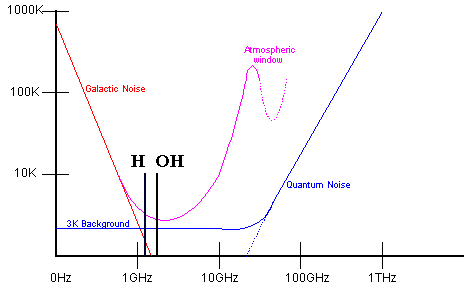
 General Information
General Information

Toward the bottom of the microwave window, radiation from the precession of interstellar hydrogen is clearly heard in our receivers at a frequency of 1420.40575 MHz (corresponding to a wavelength around 21 cm). The Hydrogen Line, first detected by Ewen and Purcell at Harvard University in 1951, provided us with our first direct evidence that space is anything but an empty void -- it is a veritable chemistry set. We hypothesize that any civilization in the cosmos which possesses radio astronomy knows about the Hydrogen Line. Since there is roughly one hydrogen atom per cubic centimeter of space, the combined voices of countless hydrogen atoms produce a raucous chorus. The very first SETI studies were conducted near the Hydrogen Line, and today it still looks like a logical place to seek deliberate beacons from beyond.
Just a little way up the spectrum, near 1660 MHz (a wavelength of 18 cm), a team of scientists at MIT Lincoln Labs detected in the 1960s a cluster of radiation lines from interstellar hydroxyl ions (OH). Like the Hydrogen Line, the Hydroxyl Lines occur near the very quietest part of the radio spectrum. They too should be known to other civilizations which have studied the cosmos at radio frequencies.
The chemist looks at H and OH and recognizes them as the disassociation products of water, the solvent essential to the very existence of life as we know it. During the landmark Cyclops study of 1971, Dr. Bernard M. Oliver, then vice-president of engineering for Hewlett-Packard Company (and later the chief of the NASA SETI program) hypothesized that the Hydrogen and Hydroxyl lines constituted obvious signposts to a natural interstellar communications band, one which would likely occur to other water-based lifeforms who had some knowledge of the radio sky. Since the H and OH lines are visible from anywhere in the cosmos, in the quietest part of the spectrum, they are markers which are by no means geocentric.
It was Barney Oliver who dubbed the spectral region between H and OH the Cosmic Water-Hole. "Where shall we meet our neighbors?" he asked. "At the water-hole, where species have always gathered."
Although other regions of the spectrum hold much promise, The SETI League and other organizations concentrate a part of their resources on the Water-Hole, in hopes that there we might detect signs of other life.
email the Webmaster | entire website copyright © The SETI League, Inc. this page last updated 4 January 2003 |
Top of Page |